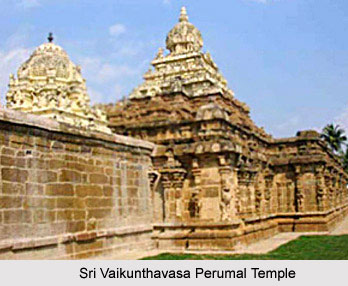 The exquisite architectural design not only points to the excellence of the craftsmanship of the artists but also provided an idea about the architectural trend of the contemporary period. However this temple is of very modest proportions. The vimana rising above the main sanctum-sanctorum is typical of Pallava architecture of the 8th-9th centuries A.D. as is evident from the shrines constructed by the kings of this dynasty at Kanchipuram and other nearby places. This Vimana testifies the exceptional craftsmanship of the then artists. The main sanctum enshrined the large image of Lord Vaikunthavasa in a seated posture
The exquisite architectural design not only points to the excellence of the craftsmanship of the artists but also provided an idea about the architectural trend of the contemporary period. However this temple is of very modest proportions. The vimana rising above the main sanctum-sanctorum is typical of Pallava architecture of the 8th-9th centuries A.D. as is evident from the shrines constructed by the kings of this dynasty at Kanchipuram and other nearby places. This Vimana testifies the exceptional craftsmanship of the then artists. The main sanctum enshrined the large image of Lord Vaikunthavasa in a seated posture
on Adisesha under the Pushpakoti Vimana facing East. The imposing image of the Lord is the best specimen of the contemporary art. Also known as Eetrirunda Perumal, the Lord is seated in the sukhasana posture with four arms. Hence He is also called Chaturbhuja. In His upper hands the lord Vaikunthavasa Perumal, holds the conch (sankha) and discus (chakra) which is in the prayoga mode. This posture points to the idea that the Lord is ready to be hurled at the foes of His devotees. His lower right hand is placed in abhaya pose as if the Lord is granting an everlasting protection to His worshippers, while His left palm holds a grain of rice pertaining to the legendary story. The captivating image of Lord Vaikunthavasa is flanked by the deities Sri Devi and Bhu Devi on the either side.
The utsava-murti or bronze processional image is extremely captivating and here is called Nitya Kalyana Perumal. A rare metal icon of Krishna with four arms, holding the sankha and chakra and playing the flute (venu) is one of the striking features of the temple. An idol of Santhana Gopalan here is placed in a separate sanctum. It is believed that the deity offer blessings on those who worship Him. An extremely beautiful bronze image of Kalinga Narthana Krishna is also seen here, holding the tail of the snake with His left hand also bears out the exceptional architectural supremacy of the artists. It is believed that when the event of paal-abhisekam is performed here, the milk turns blue in color as this is considered as Rahu-Kethu Sthala. A large number of people affected by the ill effects of Rahu, Kethu and Navagraha dosha visit this temple due to the special sanctity of this image. It is believed that the deity enshrined in the temple can remove the ill effects of these "doshas" or vices if He is worshipped properly. The shrine for Garuda decorated with snakes (nagabharana) is erected in front of the main shrine.
By the side of the small pillared mandapa in front of the principal sanctum are erected the stone images of Chakrattazhvar, a unique one of Kalinga Narthana Krishna and Vishvaksena or Senai Mudaliar. Opposite this temple, across the narrow road, there is also erected a tiny shrine dedicated to the man devotee of Lord Rama Hanuman, known here as Bhakta Vinaya Anjaneyar. Although this temple does not have a gopura over the front entrance, yet the remnants of the base of an unfinished gopura can still be seen. These have stone sculptures representing rivers Ganga and Yamuna on either side of the entrance, very characteristic of the Vijayanagara style of sculpture of about the 15th or 16th centuries A.D. Since the present temple is the relic of the original one, here is noticed the original architectural trend of the Vijayanagara times.











